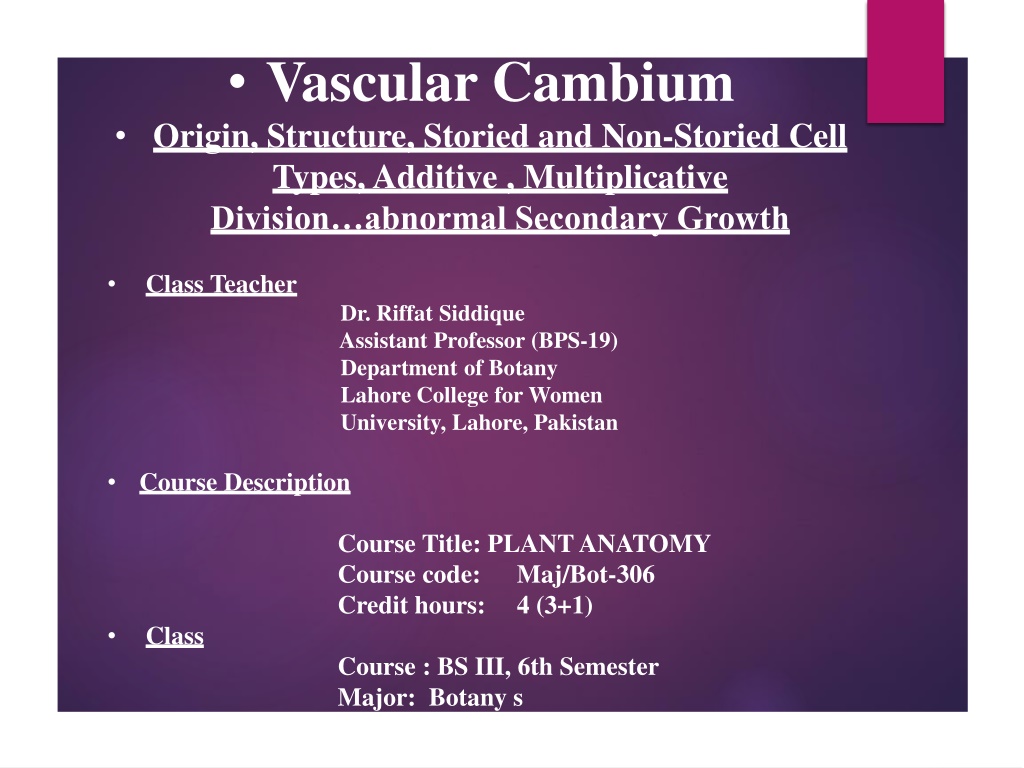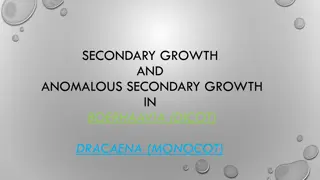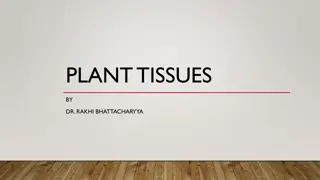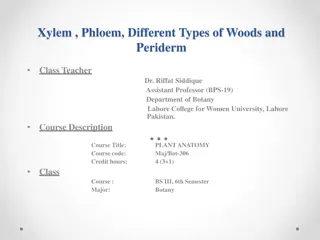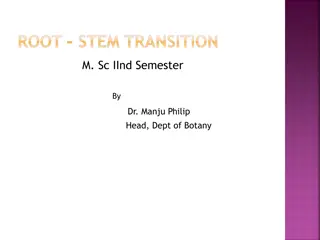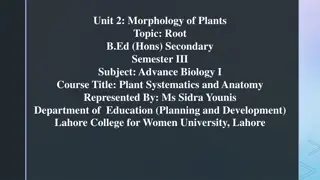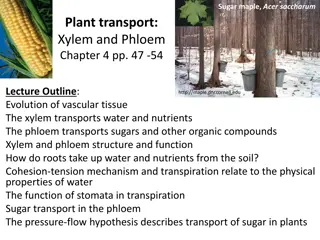Understanding Vascular Cambium in Plant Anatomy
Vascular cambium is a crucial growth layer in stems and roots, responsible for producing xylem and phloem in plants. It originates from the maturation of procambium cells, differentiating into storied and non-storied cell types. It plays a vital role in secondary growth by generating new wood in woody plants. The cambium types include intrafascicular and interfascicular cambium, forming within and between vascular bundles. The organization of vascular cambium involves vacuolated cambial cells of ray initials and fusiform initials. Understanding the structure and function of vascular cambium is essential in the study of plant anatomy.
Download Presentation

Please find below an Image/Link to download the presentation.
The content on the website is provided AS IS for your information and personal use only. It may not be sold, licensed, or shared on other websites without obtaining consent from the author. Download presentation by click this link. If you encounter any issues during the download, it is possible that the publisher has removed the file from their server.
E N D
Presentation Transcript
Vascular Cambium Origin, Structure, Storied and Non-Storied Cell Types, Additive , Multiplicative Division abnormal Secondary Growth Class Teacher Dr. Riffat Siddique Assistant Professor (BPS-19) Department of Botany Lahore College for Women University, Lahore, Pakistan Course Description Course Title: PLANT ANATOMY Course code: Credit hours: Maj/Bot-306 4 (3+1) Class Course : BS III, 6th Semester Major: Botany s
Vascular Cambium The vascular cambium is the main growth layer in the stems and roots. Specifically in dicots such as buttercups and oak trees, and gymnosperms such as pine trees. It produces xylem on the inside and phloem on the outside. In herbaceous plants, it occurs in the vascular bundles. In woody plants, it forms a continuous ring and grows new wood on the inside.
Origin of Cambium The primary vascular tissue is formed by the maturation of the cells of the procambium strands. In plants where secondary growth is absent all the cells of the procambium strand mature and develop into vascular tissues. Not all the cells of the procambium strand mature into vascular tissues rather some tissues remain meristematic Arrange itself between the xylem and phloem of primary nature.
Types of Vascular Cambium Intra Fascicular Cambium: The cambium that arises within the bundles of primary vascular tissue of the stem is known as intra fascicular cambium. Inter Fascicular Cambium: The strip of intra fascicular cambium generally becomes jointed by additional strips of cambium which are called Inter fascicular cambium.
Types of Vascular Cambium Source: https://www.google.com /search?q=Intra+Fascicul ar+Cambium&safe=activ e&sxsrf=ALeKk02XcEOo4U PH8_jxp934a7x4Clb6IQ:15 88708964641&source=lnm s&tbm=isch&sa=X&ved=2 ahUKEwidlfSLwp3pAhWKz IUKHWvrCLwQ_AUoAXoE CA4QAw&biw=1366&bih =657#imgrc=vzH23PB4Pn aG4M&imgdii=AwEEUlbh DnBewM
Organization of Vascular Cambium The cells of vascular cambium are different from the general meristematic cells. The cambial cells are vacuolated. The resting cells have less of vacuoles but the active cambial cells are highly vacuolated. The cambial cells are of two kinds ray initial and fusiform initial:
Kinds of cambial cells Ray Initials: These are much smaller than fusiform initials, slightly elongated and nearly isodiametric in shape. They produce radial system of the cambial zone. Fusiform Initials: The term fusiform implies that the cell is shaped like a spindle. A fusiform initial, however, is a prismatic cell in its middle and wedge shaped at the ends.
Ray and Fusiform Initials Source: http://www.bio logydiscussion. com/stems- 2/dicot- stem/secondar y-growth-in- dicot-stem- with- diagram/70397
Vascular Cambium Types Storied or Stratified Cambium: In this case the fusiform initials are shorter and are arranged in horizontal rows. This kind of cambium is found in Tamarix and Robinia etc. According to Bailey the storied cambium have evolved by gradual reduction of the size of the cells and by longitudinal sliding growth.
Non-Storied or Non- Stratified Cambium: In this case the fusiform initial are longer, partially overlap one another. They are not arranged in horizontal rows. This kind of cambium occurs more commonly in plants.
Storied and Non-storied cambium Source: https://sl ideplaye r.com/sli de/5275 295/
Structure and functions: The cambium join up to form a ring. Separates the primary xylem and primary phloem, the cambium ring. The vascular cambium produces secondary xylem on the inside of the ring, and secondary phloem on the outside. Pushing the primary xylem and phloem apart. intrafascicular and interfascicular
Maintenance of cambial meristem: The vascular cambium is maintained by a network of interacting signal feedback loops. Currently, both hormones and short peptides have been identified. Similar regulation occurs in other meristems of plants. The cambial meristem receives signals from both the xylem and phloem sides for the meristem.
Hormonal regulation: The hormones that are involved in the vascular cambial activity are gibberellins, cytokinins, abscisic acid and more to be discovered. auxins, ethylene, Each one of these plant hormones are vital for the regulation of the cambial activity and are dependent on their concentration.
Hormonal regulation: Auxin: This hormone is proven to stimulate mitoses, cell production and regulate interfascicular and fascicular cambium. Applying auxin to the surface of a tree stump allowed shoots to continue secondary growth. The absence of auxin hormones will have a great effect on a plant. Reduced growth of the vascular bundles. Auxin also regulates the two types of cell in the vascular cambium, ray and fusiform initials. Regulation of these initials ensures the connection and communication between xylem and phloem is maintained for the translocation of nourishment and sugars are safely being stored as an energy resource.
Hormonal regulation: Gibberline: Stimulates the cambial cell division. Regulates differentiation of the xylem tissues, with no effect on the rate of phloem differentiation. Differentiation is an essential process that changes these tissues into a more specialized type, playing an important role in maintaining life form of plant.
Hormonal regulation: Cytokinin: This hormone is known to regulate the rate of the cell division. A study demonstrated that the mutants are found to have a reduction in stem and root growth but the secondary vascular pattern of the vascular bundles were not affected with a treatment of cytokinin.
Cell Division in Vascular Cambium: When, the cambial initials produce secondary xylem and phloem, the divide periclinally. At one time a derivative cell is formed towards the xylem, at another time towards the phloem. It s not necessarily in alternation. Each cambial initial forms radial files of cells one towards the outside and the other towards inside and the two files meet at the cambial initial.
With the increase in thickness of core of secondary xylem, the cambium is displaced outwardly. Circumference enhances. The increase is accomplished by divisions of cells. The phenomenon is called dilation. New ray cells are also added. They form additional rays every year. The vascular cambium undergoes two types of divisions additive (periclinal divisions for formation of secondary tissues) and multiplicative (anticlinal divisions for dilation). Ray initials produce radial system (= horizontal or transverse system) while fusiform initials form axial system (= vertical system) of secondary vascular tissues.
Cell Division in Cambium Source:http://www- plb.ucdavis.edu/labs/rost/Tomato/S tems/secstem3.html https://slideplayer.com/slide/107 52669/
Seasonal Activity of Vascular Cambium: In plants growing in tropical regions, cambium is active throughout the whole life of plants. In contrast to this, in plants of temperate region, the cambium almost ceases its activity with the commencement of unfavourable season. generally in autumn and this dormant stage remains till the following spring when it is reactivated and produces new xylem and phloem. The cambial cells take up water, enlarge radially and divide periclinally.
The Vascular Cambium and Secondary Growth: The vascular cambium and cork cambium are secondary meristems formed in stems and roots. After the tissues of the primary plant body have differentiated. The vascular cambium is responsible for increasing the diameter of stems and roots and for forming woody tissue. The cork cambium produces some of the bark.
The Vascular Cambium and Secondary Growth In dicot stems, the vascular cambium initially differentiates from procambial cells within the vascular bundles. Monocots do not have a vascular cambium, some of them, such as palms and the Joshua tree, exhibit secondary growth. They have a thickening meristem that produces secondary ground tissue. Increases the girth of the stem and additional vascular bundles differentiate within the secondary ground tissue.
Anomalous Secondary Growth: It is abnormal type of secondary growth that occurs in some arborescent monocots (e.g., Dracaena, Yucca, Agave) and storage roots (e.g., Beet, Sweet Potato). In arborescent monocot stems, a secondary cambium grows in hypodermal region. The latter forms conjunctive tissue and patches of meristematic cells. The meristematic patches grow into sec- ondary vascular bundles. Anomalous vascular bundles also occur in cortex (cortical bundles, e.g., Nyctanthes) and pith (e.g., Boerhaavia). In storage roots (e.g., Beet), accessory cambial rings appear on the outside of endodermis. They produce less secondary xylem but more secondary phloem. The secondary phloem contains abundant storage parenchyma. http://www.biologydiscussion.com/stems-2/dicot- stem/secondary-growth-in-dicot-stem-with-diagram/70397
Importance of Secondary Growth: 1. It is a means of replacement of old non-functional tissues with new active tissues. 2. The plants showing secondary growth can grow and live longer as compared to other plants. 3. It provides a fire proof, insect proof and insulating cover around the older plant parts. 4. Commercial cork is a product of secondary growth. It is obtained from Quercussuber (Cork Oak). 5. Wood is a very important product of secondary growth. It represents secondary xylem.
